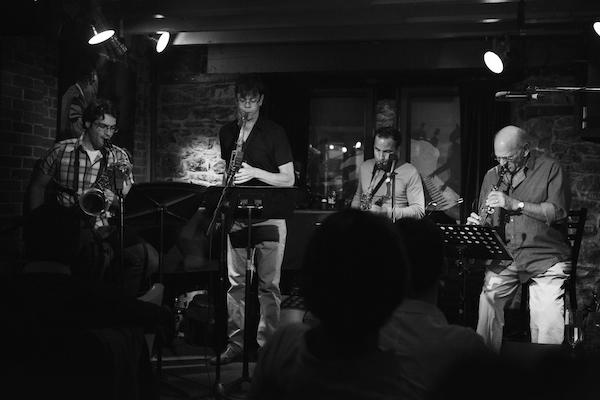Apr 2, 2024 12:59 PM
Saxophonist, Sonic Explorer Casey Benjamin Dies at 45
Casey Benjamin, the alto saxophonist, vocalist, keyboardist and producer who stamped his distinctive sounds on the…

Saxophonists Samuel Blais (left), Donny McCaslin, David Binney and Dave Liebman make up the Four Visions Saxophone Quartet, a group that can trace its lineage back to jazz and the work of classical saxophonist Marcel Mule.
(Photo: Courtesy Sunnyside)Wind ensembles that work without a rhythm section are tricky.
Horn quartets flout accepted rhythmic and harmonic conventions and don’t have much of their own repertoire. They’re latecomers to jazz, relatively speaking, and don’t conjure up a readily identifiable sound in listeners’ imaginations. But a few modern groups have disrupted—and continue to disrupt—long-held notions of these woodwind ensembles and brass bands.
As a young saxophonist in Detroit, James Carter loved the groundbreaking World Saxophone Quartet, with its experimental use of rhythmic melodicism, jolting harmony and free improvisation. By high school, “I’d heard four of their albums—Point Of No Return, Steppin’ With The World Saxophone Quartet, W.S.Q. and Revue,” Carter recalled. The albums changed his understanding of what the saxophone could do.
Recorded in the late 1970s and early 1980s, the LPs Carter mentioned have become formative recordings for jazz saxophone ensembles. Begun in 1976, the group reflected the configuration of classical saxophone quartets, with group founders Oliver Lake on soprano and alto, Julius Hemphill on alto, David Murray on tenor and Hamiet Bluiett on baritone. Their sound only hinted at the classical world, however. They pulled much of their repertoire from swing, rock, funk, soul and r&b, and they improvised creatively over only the sketchiest of changes.
So taken was Carter with the WSQ that while still in high school he started his own sax quartet, called The Plumbers, “because horns are like pipes,” he explained. “[Alex Harding, JD Allen, Harry Patton and I] wanted to recreate that [WSQ] sound, but we didn’t have any plans for the group. We played for our own personal delight.”
By the time Carter graduated high school, that personal delight had progressed into professional accomplishment: In 1982, Carter shared the stage with his idols when the WSQ visited Detroit. Hearing Bluiett’s “Hattie Wall,” one of the group’s most popular tunes, directly from the horn of its composer blew Carter’s mind.
Today, Carter—who places consistently in DownBeat polls—is one of the last official members of the WSQ. He joined the group in 2011, taking over for saxophonist John Purcell, who’d filled the spot left empty by Hemphill’s death in 1995. By the time Carter joined, he had subbed plenty with the group, so he fit in seamlessly as a replacement; that same year WSQ released Yes We Can (Jazzwerkstatt), the group’s collective homage to then-President Barack Obama.
Recorded live in Berlin in 2009, the album is Carter’s first and only recording to date with the WSQ, and the group’s last with founding member Bluiett, who passed away in October 2018. (Kidd Jordan played alto on the album, instead of original member Lake.)
Carter observed that in the years since he joined, and as Blueitt’s health declined, the ensemble’s performance schedule ebbed—regrettably. He doesn’t see this slowdown as an end to the quartet, however; he can readily imagine a WSQ revival. After all, some historic bands, like the Count Basie Orchestra, continue to outlive its founders, as the creative baton is passed to the next group of willing and qualified musicians.
This could be the case with the WSQ. “Besides [Murray and Lake], there are other players who’ve worked with the quartet over the years and could fill in,” Carter noted.
And he’d like to see that happen.
“For me, the World Saxophone Quartet was freedom at its supreme height,” he concluded.
THE FREEDOM THAT CARTER EXTOLS was hard-won, however, and an integrated all-horn sound still isn’t easy for contemporary brass jazz quartets to achieve. NEA Jazz Master saxophonist Dave Liebman, who’s recorded recently with two all-saxophone groups, explained the challenges these ensembles frequently face.
“The classical world is definitely more into horn-only textures than the jazz world is,” he pointed out. “And the [modern jazz] saxophone quartet is really borrowing from the classical world.”
From Marcel Mule, the French classical saxophonist, specifically. In the late 1920s, Mule created the first classical saxophone quartet, a symphonic group that worked without any rhythmic or chordal intervention. Later, jazz musicians co-opted the idea that an ensemble doesn’t need a bass, drum or chordal instrument and can rely solely on the colors of the horns to create a desired effect.

Benjamin possessed a fluid, round sound on the alto saxophone, and he was often most recognizable by the layers of electronic effects that he put onto the instrument.
Apr 2, 2024 12:59 PM
Casey Benjamin, the alto saxophonist, vocalist, keyboardist and producer who stamped his distinctive sounds on the…

“He’s constructing intelligent musical sentences that connect seamlessly, which is the most important part of linear playing,” Charles McPherson said of alto saxophonist Sonny Red.
Feb 27, 2024 1:40 PM
“I might not have felt this way 30 to 40 years ago, but I’ve reached a point where I can hear value in what people…

Albert “Tootie” Heath (1935–2024) followed in the tradition of drummer Kenny Clarke, his idol.
Apr 5, 2024 10:28 AM
Albert “Tootie” Heath, a drummer of impeccable taste and time who was the youngest of three jazz-legend brothers…

“Both of us are quite grounded in the craft, the tradition and the harmonic sense,” Rosenwinkel said of his experience playing with Allen. “Yet I felt we shared something mystical as well.”
Mar 12, 2024 11:42 AM
“There are a few musicians you hear where, as somebody once said, the molecules in the room change. Geri was one of…

Larry Goldings’ versatility keeps him in high demand as a leader, collaborator and sideman.
Feb 21, 2024 10:45 AM
Are you having any fun? Larry Goldings certainly is. Consider just two recent examples:
Scene 1: “If anyone had…